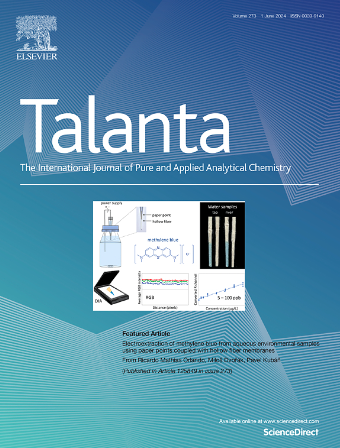Structure-switchable dsDNA promoter regulates the activity of CRISPR-Cas12a for APE1 detection
IF 5.6
1区 化学
Q1 CHEMISTRY, ANALYTICAL
引用次数: 0
Abstract
Apurinic/apyrimidinic endonuclease 1 (APE1) has been considered as a promising biomarker since it is associated with numerous human diseases, involving neurodegenerative diseases and cancer. However, current APE1 detection methods mainly rely on immunology-based methods, which are burdened by time-consuming and procedural complexity. To overcome these shortcomings, we have developed an innovative all-in-one technique that simplifies APE1 detection by integrating enzyme-responsive elements structure-switchable dsDNA promoter with CRISPR/AsCas12a methodology, namely EDC. In this work, the structure-switchable dsDNA promoter has been well-designed to trigger the site-directed incision of APE1 and then release the split activator to illumine the CRISPR/AsCas12a catalyst system by coupling it with another truncated activator. Under optimal circumstances, the proposed strategy enables sensitive detection of the target APE1 with a detection limit of 4.8 × 10−5 U/mL and a wide linear range from 5.0 × 10−5 to 1.0 × 10−1 U/mL. Moreover, this strategy could be gratifyingly applied to screen APE1 inhibitors and monitor APE1 in lysates from cell extractions or clinical serum samples. Overall, this study presents a novel approach that utilizes dsDNA promoter as programmable switching components, effectively enhancing CRISPR/Cas12a-based diagnostic platforms and demonstrating the significant potential for clinical translation.

结构可切换的dsDNA启动子调节CRISPR-Cas12a的活性以检测APE1
无嘌呤/无嘧啶内切酶1 (APE1)被认为是一种很有前途的生物标志物,因为它与许多人类疾病有关,包括神经退行性疾病和癌症。然而,目前的APE1检测方法主要依赖于基于免疫学的方法,这些方法耗时且程序复杂。为了克服这些缺点,我们开发了一种创新的一体化技术,通过将酶反应元件结构可切换的dsDNA启动子与CRISPR/AsCas12a方法结合,即EDC,简化了APE1的检测。在这项工作中,结构可切换的dsDNA启动子被精心设计为触发APE1的位点定向切割,然后释放分裂激活子,通过将其与另一个截断的激活子偶联来照亮CRISPR/AsCas12a催化系统。在最佳情况下,该策略能够对目标APE1进行灵敏检测,检出限为4.8 × 10−5 U/mL,线性范围为5.0 × 10−5 ~ 1.0 × 10−1 U/mL。此外,该策略可以令人满意地应用于筛选APE1抑制剂和监测细胞提取或临床血清样本裂解物中的APE1。总的来说,本研究提出了一种利用dsDNA启动子作为可编程开关组件的新方法,有效增强了基于CRISPR/ cas12的诊断平台,并展示了临床翻译的巨大潜力。
本文章由计算机程序翻译,如有差异,请以英文原文为准。
求助全文
约1分钟内获得全文
求助全文
来源期刊

Talanta
化学-分析化学
CiteScore
12.30
自引率
4.90%
发文量
861
审稿时长
29 days
期刊介绍:
Talanta provides a forum for the publication of original research papers, short communications, and critical reviews in all branches of pure and applied analytical chemistry. Papers are evaluated based on established guidelines, including the fundamental nature of the study, scientific novelty, substantial improvement or advantage over existing technology or methods, and demonstrated analytical applicability. Original research papers on fundamental studies, and on novel sensor and instrumentation developments, are encouraged. Novel or improved applications in areas such as clinical and biological chemistry, environmental analysis, geochemistry, materials science and engineering, and analytical platforms for omics development are welcome.
Analytical performance of methods should be determined, including interference and matrix effects, and methods should be validated by comparison with a standard method, or analysis of a certified reference material. Simple spiking recoveries may not be sufficient. The developed method should especially comprise information on selectivity, sensitivity, detection limits, accuracy, and reliability. However, applying official validation or robustness studies to a routine method or technique does not necessarily constitute novelty. Proper statistical treatment of the data should be provided. Relevant literature should be cited, including related publications by the authors, and authors should discuss how their proposed methodology compares with previously reported methods.
 求助内容:
求助内容: 应助结果提醒方式:
应助结果提醒方式:


